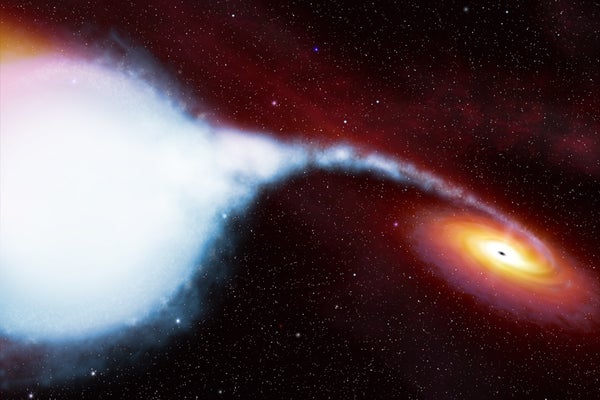How Can You ‘See’ a Black Hole?
How do astronomers find the darkest objects in the universe?
By Phil Plait

An illustration of the black hole Cygnus X-1, the first ever glimpsed by astronomers. The stellar-mass black hole (right) siphons gas from its companion, a blue supergiant star (left). This material forms a whirling, glowing accretion disk around the black hole, revealing the dark object’s presence.
NASA, ESA, Martin Kornmesser (ESA/Hubble) (CC BY 4.0)
Imagine an object with gravity so powerful that nothing, not even light, can escape after falling in. Such a beast would be like an infinitely deep hole and utterly black.
Someone should come up with a catchy name for it.
Black holes are probably the most popular astronomical objects among the public. Whenever I give talks, the audience peppers me with questions about them even when my topic is something completely different. People love a good monster story, and black holes are the scariest of them all.
On supporting science journalism
If you’re enjoying this article, consider supporting our award-winning journalism by subscribing. By purchasing a subscription you are helping to ensure the future of impactful stories about the discoveries and ideas shaping our world today.
They were just a hypothesis for a long time. Then, in the 1960s, astrophysicists found the first direct evidence of a black hole, which lurked relatively nearby within the Milky Way. But how do you find something if, by definition, it’s effectively invisible?
Surprisingly, there are lots of ways to uncover these voracious objects. And ironically, the very thing that makes them so dark—their gravity—is what betrays their presence.
Our first glimpse of a black hole came in 1964 via two small suborbital sounding rockets that were launched to survey and map x-ray sources across most of the sky. One of these sources, located in the constellation of Cygnus, was quite powerful and appeared in many follow-up observations. Astronomers dubbed it Cygnus X-1 because it was the first x-ray source found in that constellation. As observations improved, astronomers could pinpoint this source in the sky, revealing a bright star at its location some 7,000 light-years from Earth. Even though this star was massive and luminous, it had nowhere near the wherewithal to emit x-rays at the amount detected. All that radiation was coming from something else.
Theories predicted the source must be a black hole. If one orbits a star closely, its ridiculously strong gravity can draw in matter from that star. This material spirals into the black hole and does eventually fall in. But first it forms a flat disk called an accretion disk just above the black hole’s point of no return—the boundary, called an event horizon, beyond which not even light can escape. Matter orbiting nearer to the black hole moves more rapidly—close to the speed of light!—while matter farther out moves more slowly. As the material in the disk rubs against itself, it generates a vast amount of friction, heating up to millions of degrees. Hot material glows, and this stuff is hellishly hot, so it emits copious amounts of light. We can see that light, not so incidentally, because it’s emitted outside the black hole’s event horizon.
That emission includes x-rays, which are just a high-energy form of light. The actual physics are dauntingly complex, involving swirling magnetic fields of incredible strength, but in the end, just above the black hole’s event horizon, that matter can blast out x-rays. This was—and still is—considered extremely strong evidence for Cygnus X-1 being a black hole.
Further study of the massive star in its location supported that conclusion as well: research revealed that the star was in a tight orbit with a massive object, something that had around 20 times the mass of our sun yet emitted no light. A star that was so massive would be incredibly luminous, so whatever the companion was, it was dark. Hence, it was a black hole. (It’s weird and rather fun that one piece of evidence for the existence of black holes is when we don’t see them.)
Around the same time Cygnus X-1 was shown to be a stellar-mass black hole, astronomers were also finding objects that were much more distant, some billions of light-years away, yet still so bright that they initially were mistaken for stars. Such “quasi-stellar objects,” or quasars, must be phenomenally luminous to be seen at all from so far off. Astronomers eventually realized quasars had to be powered by enormous black holes, each with a mass that was millions or even billions of times that of the sun. Huge amounts of material were flowing into them, creating immense, glowing accretion disks so bright that they could be seen from across the universe. We now know that almost all big galaxies have such a supermassive black hole in their center—the Milky Way’s is called Sagittarius A*, or Sgr A*, and is about four million solar masses—and that these objects profoundly affect the birth and growth of whole galaxies. Very few are now eating enough material to become a glowing quasar, but enough do that we see millions of such “active” galaxies across the cosmos.
Yet black holes don’t need to announce their existence so flamboyantly. Some stellar-mass black holes reside in wider orbits with their companion star and aren’t accreting material. Even in these cases, painstaking measurements can reveal the companion star’s motion as it circles the compact, dark object. This is very difficult to detect, however, and only a few black holes have been found that way. Using data on stellar motions from the European Space Agency’s Gaia spacecraft, astronomers recently found one that’s only 2,000 light-years from Earth. Presumably, black holes that are even closer to us are out there, too, as yet unseen. We’re probably not in any danger—the odds of encountering one adrift in the Milky Way are extremely long. But there are likely tens of millions of such quiescent black holes in our galaxy alone.
Sometimes a black hole doesn’t have to be physically near any other objects to reveal its presence either. One of Albert Einstein’s brilliant ideas was that gravity warps space, and light has to follow that distorted path like a truck driving down a curving road. Light passing through the powerful gravitational field of a black hole can be wildly distorted, an effect called strong gravitational lensing. Astronomers have recently used this method to discover and weigh a supermassive black hole tipping the cosmic scale at more than 30 billion solar masses in a galaxy nearly three billion light-years away. It happens to lie almost exactly in the same direction as a much more distant galaxy, and the distortion in that background galaxy’s light revealed the black hole’s presence and immense mass.
In a related Einstein-predicted effect, when two black holes collide, they can send out powerful ripples in the fabric of spacetime called gravitational waves. Many massive stars are born in binary systems, and each of the two stars in such systems can in turn explode as a supernova, leaving behind a black hole. Over time, the two compact objects spiral together until they merge in a colossal blast of gravitational waves. These were first detected in 2015, and we’ve now seen well more than 100 such events. A European Space Agency mission called the Laser Interferometer Space Antenna, or LISA, is designed to detect giant gravitational waves, including those from the mergers of supermassive black holes that are thought to occur after whole galaxies collide. And LISA may find hundreds of such events after its projected launch date in the mid-2030s.
Our understanding of black holes went from considering them to be purely hypothetical to seeing them everywhere pretty rapidly. We now know they play critical roles in the evolution of stars and galaxies, yet we still have more questions than answers. How do they form? How did supermassive black holes get so big so rapidly at the dawn of the universe? Can they die?
Black holes can hide, but honestly, in a lot of cases, they’re just not very good at it. We can spot them, and the more we do, the more answers we can find.
>>> Read full article>>>
Copyright for syndicated content belongs to the linked Source : Scientific American – https://www.scientificamerican.com/article/how-can-you-see-a-black-hole/


























![Forest ecology cannot be reduced to arithmetic, says M.I. Varghese [Interview] – Mongabay-India](https://earth-news.info/wp-content/uploads/2025/12/328946-forest-ecology-cannot-be-reduced-to-arithmetic-says-mi-varghese-interview-mongabay-india-120x86.jpg)




